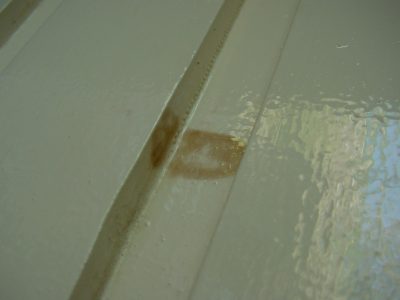
UPDATED: 9Apr2020
Got knots bleeding through painted woodwork? This is the kind of question that I get regularly from readers:
Q: “How can I stop knots from bleeding through after painting? The knots are hidden at first, but eventually brown colour shows through.”
You can see a typical example of this problem at the photo here. The staining even came through heavy coats of oil-based paint. There doesn’t seem to be any amount of paint that can stop this, so what can you do?
You’d think multiple coats of paint like this would be more than enough to seal knots in pine and other softwoods, but it’s not. Knot stains on painted wood showing through over time is a common problem, and the solution isn’t immediately obvious. What you need is an effective knot stain block.
First of all, some types of wood is definitely worse than others when it comes to knots bleeding through painted wood. Newer pieces of softwood are more likely to have resins and oils than older pieces of the same species of wood. Given enough time the oils and resins seep through even the thickest ordinary paint, causing those ugly brown stains. I’m all for the beauty of knots in wood, but when they show up through paint – especially light coloured paint – it looks really bad.
So, what can you do? There’s a mistaken belief that daubing a coat of shellac on the knots before painting (or repainting) will do the trick. I’ve never seen this work long-term. It might slow the stains down, but it won’t stop them from appearing through paint. Those sneaky knot stain bleeds keep coming back.
The only thing I’ve found that works are products specifically sold as “stain-blocking” primer. This is the same stuff used to seal in smoke odours and other kinds of smells before painting in restoration work. I’ve used Zinsser’s BIN product with good results. Roughen the surface of the existing paint with some 120-grit sand paper used by hand, daub a coat of stain blocking primer on the knots, add another coat in the same way, then use 100% latex paint as usual on top. This even works over old oil paints if you use the right kind of primer. Use this same procedure on new woodwork that has knots. Another option is to use knot-free hardwood trim or composite trim and moulding if you’d rather avoid knots altogether.
Do you have a huge expanse of wood you’d like to paint? Perhaps a tongue-and-groove pine ceiling or wall? Consider applying 1/4″ drywall over the wood, then finishing and painting that. I won’t be much more work and it will offer a smoother surface with no chance of being too visually busy.
Got some new woodwork to finish? Want a stained and sealed look? Check out my video below that explains all the steps to creating a terrific stained and sealed finish on solid wood and veneers.